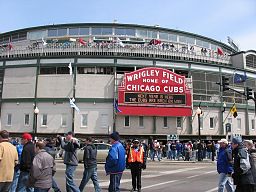As a nearly 50-year Cubs fan (a lifetime mission, I call it), I can’t let the 100th anniversary of Wrigley Field happen without some commentary.
Wrigley was born on April 23, 1914 – exactly 98 years ago, minus one day. About 20,000 fans jammed into the brand new ballpark built for 14,000 that day to see the old Chicago Federals defeat the Chicago Packers, 9-1. Wrigley cost about $250,000 to build (compare that to the estimated cost of renovations now).
As the above item reveals, Wrigley did not start with the Cubs. The team and the park did not connect until 1916, two years after the park was built. The Cubs played in the West Side Stands in another part of Chicago in 1914-15.
For a century, Wrigley has been arguably the most talked-about landmark in baseball and Chicago. Here are a few myths and facts about what P.K. Wrigley called “Beautiful Wrigley Field:”
Fact: It was the first major ballpark to be built out of concrete and steel, instead of rickety wood.
Fact: The original left field bleachers were torn down in 1925 because opposing hitters were hitting two many home runs into them. And it wasn’t even the live ball era yet!
Fact: While the Cubs have enjoyed record attendance and consistent sellouts in the last decade, it wasn’t always that way. One game in 1966 drew about 600 fans. One year’s total attendance in the ’60s was 609,000.
Myth: The ivy was installed in 1937, and some say it became a hiding place for balls outfielders needed to find quickly to throw a runner out.
Fact: Wrigley remains the only major league park with ivy-covered walls.
Fact: Wrigley’s manually-operated scoreboard has never been hit by a batted ball. Babe Ruth’s alleged “called shot” in 1932 didn’t reach the board. But the Yankees’ Lou Gehrig clouted an historic shot at Wrigley when he was only 17. In an exhibition game with his high school team, Gehrig smashed a three-run homer onto Sheffield Avenue to win the contest, 9-8.
Fact: The scoreboard has been hit by a golf ball, however. Teeing off at home plate, Sam Snead hit the board once and hit a drive over it before a game in 1951.
Fact: Wrigley was the first ball park to allow fans to keep foul balls, the first to feature organ music, and the first to build permanent concession stands.
Fact: Wrigley has been the scene of Chicago Bears football, circuses, concerts, boxing matches, pro wrestling, a rodeo, soccer games, a Chicago Blackhawks hockey game, and ski jumping. On a couple of weekends in 1944, ski jumpers leapt from scaffolding covered in snow, landing behind second base.
Fact: Wrigley was home to the highest scoring game in major league history, a 26-23 Cub victory over the Phillies on Aug. 25, 1922.
Finally, a personal memory: On a hot day in the 1980s in the right field bleachers, my family and I noticed a guy roaming the nearby seats, loudly challenging fans to make bets on every pitch. He had a wad of money in his hand and eventually it was revealed he had a pistol stashed in one of his socks. As Andy Frain ushers approached him, he walked out of the park and disappeared. Wrigley’s enormous power to attract all kinds of fans is a big part of its history.
Happy 100th, you beautiful sports monument. I hope with all my heart that someday you’ll achieve something you’ve been searching for all your life: A Cubs World Series victory.





